Baby Axolotl is among one the most unusual amphibians in the world. They are called Mexican walking fish or Mexican salamanders commonly. They are called Ambystoma mexicanum scientifically.
Usually, salamanders change their physical appearance throughout their life cycle. In contradiction, Baby Axolotls are stuck in their larval stage and will not metamorphose. This is the point that makes Baby Axolotl unique from the other salamanders. They are entirely aquatic and have external gills, even though they develop lungs. Further, they never venture onto land.
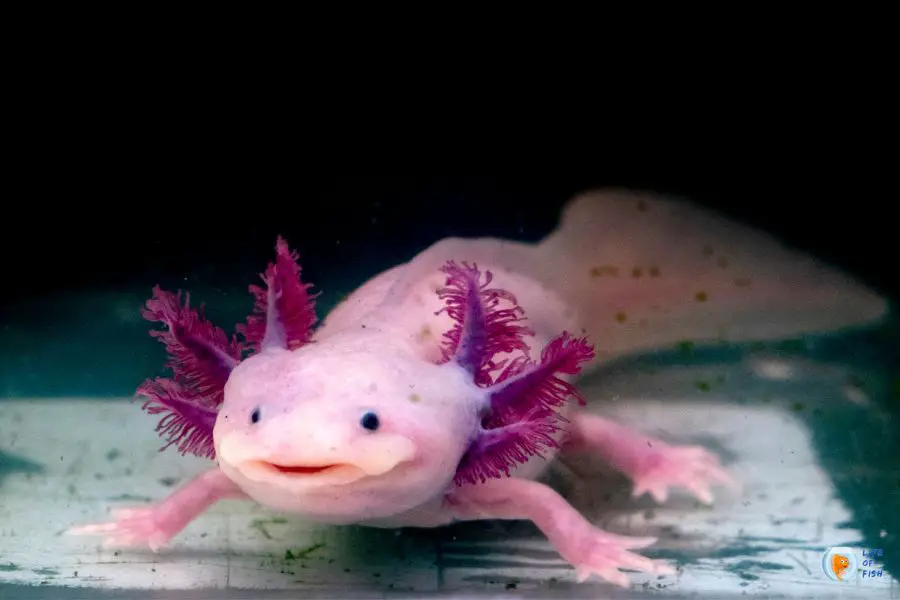
Scientifically, they are known as neotenic salamanders. It is a trait where an animal never entirely loses its juvenile characteristics. Baby Axolotls have external gills and they never disappear throughout their lifetime. They are mostly related to Tiger Salamanders (Ambystoma tigrinum).
The native land of Baby Axolotls is the lake of Xochimilco in Mexico. They are categorized as critically endangered, on the IUCN conservation index. Their numbers are in sharp decline and going extinct in the near future. The reasons for the decline in numbers are Water pollution, Overfishing, Habitat loss, and Invasive species. However, there are more axolotls in captivity and this only applies to wild species.
One look guide
Jump To
| Scientific name | Ambystoma mexicanum |
| Common name | Baby Axolotl, Walking fish |
| Care level | complex |
| Native to | Xochimilco lake complex, Mexico |
| Type | Freshwater salamander |
| Color | combination of brown, green, and gold |
| Water quality | pH: 6.5-8.0 Chlorine: 0 ppm Ammonia: 0 ppm Nitrite: 0 ppm Nitrate: 0-10 ppm Water Hardness: 7-14 GH Carbonated Hardness: 3-8 KH |
| Preferred temperature | Temperature: 60-70°F (15-23°C) |
| Preferred salinity | Freshwater species |
| Growth rate | Rapid |
| Preferred food | Angleworms, Bloodworms, Brine shrimp, Frozen fish pellets |
| Breeding | Egg layers |
How big does Axolotl get?
The average length of a fully grown axolotl is 9 inches on average. Usually, the axolotls which are around 2.5-4 inches in length are considered young adults.
Their behavior
Axolotls are fascinating creatures to observe due to their beautiful and unusual appearance and their behavior. They are claimed to be nocturnal and you can see they are more active at night or in soft-lit areas. They spend the majority of their time sitting at the tank surface since they are typically sloppy species.
Because of their welcoming personality and overall charm and a big smile, many of them think they are innocent creatures. But actually, they are furious carnivores like their close relations, salamanders, and will consume literally anything.
Baby axolotls are not considered a suitable species for a community tank due to their very aggressive nature. They cannot be housed with fish species, amphibians, shrimp, and perhaps other animals since they tend to bite, nip, and swallow their prey without any warning. The juvenile axolotls(measurements 8 to 16 cm) never be kept together with individuals of the same species due to the risk of significant injury from nipping one another’s fins and limbs.
Baby axolotls like to live alone and therefore the experts advise keeping them alone.
Although the grown-up axolotls do not engage in fights like their juveniles It is always good to keep them isolated.
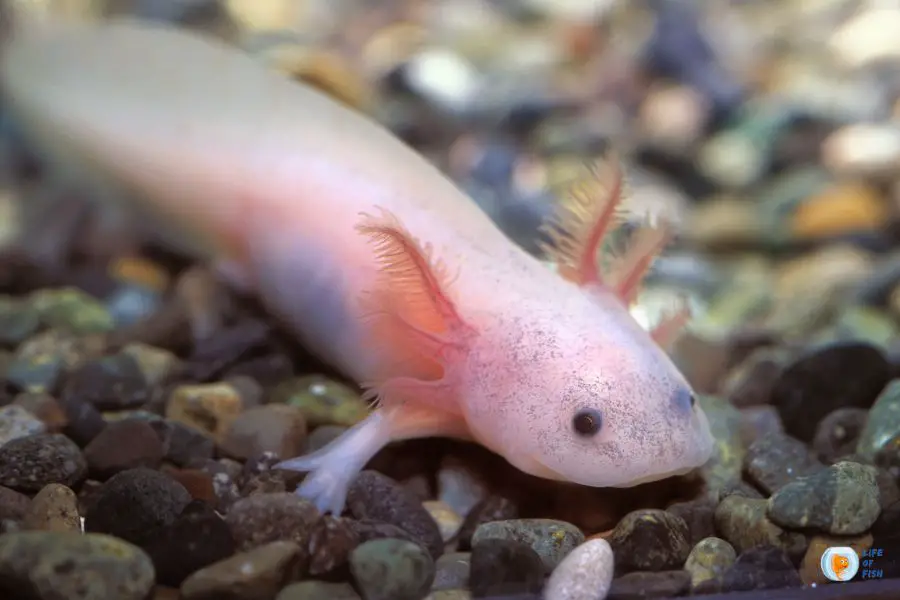
Axolotl Lifespan
According to the research, they can live up to 15 years. However, the specimens in captivity live for 10 years on average.
Baby Axolotl care
Baby Axolotl tank size
These cute creatures do not need a lot of space and even adult axolotls can survive in a little room. This is because they do not have fast metabolisms, nor do they move around too much. Usually, a 10-gallon of the freshwater aquarium will be sufficient for a baby axolotl for its entire lifetime. However, some aquarists say, it is better to upgrade the tank once your axolotl reaches 6 inches of at least 20 gallons of the tank. There is a reason behind this.
Adult axolotls are very messy animals. Therefore they create more ammonia and poop and most of the best filters cannot afford this amount. If you keep them in a smaller tank, the water will easily foul as the water volume is less. Further, you need to do frequent partial water changes. In contrast, if you keep them in a larger tank, a high volume of water will help you prevent poor water quality from impacting their health.
How many Baby Axolotl should be kept together?
Baby axolotls are very aggressive carnivorous species. They are not a social species and do not need any other fish or axolotl to survive.
You can keep many newly hatched axolotls together. However, when they become young, you should separate them. It is said that you can house axolotls together, as long as they are roughly the same size. Generally, divide them up based on size when they reach about 2 cm in size. At this stage, they start exhibiting cannibalistic traits. They will snap at anything moving.
Like many other amphibians, they can regenerate missing limbs or other body parts that are lost during a fight. However, the regenerated limbs may not work efficiently like the previous ones and also the wounds may still get infected causing disease.
Therefore, unless you plan on breeding axolotls it is best to keep them solo.
If you are still interested in keeping two of them together, choose a tank of 40 gallons (20 gallons per Axolotl) to put them in. Choosing an adult pair is a good move because according to some aquarists grownup axolotls that have achieved maximum size may live harmoniously and hardly engage in fights. However, make sure the two of them are the same size. Provide them with enough food and the right tank conditions to make them less stressed and aggressive.
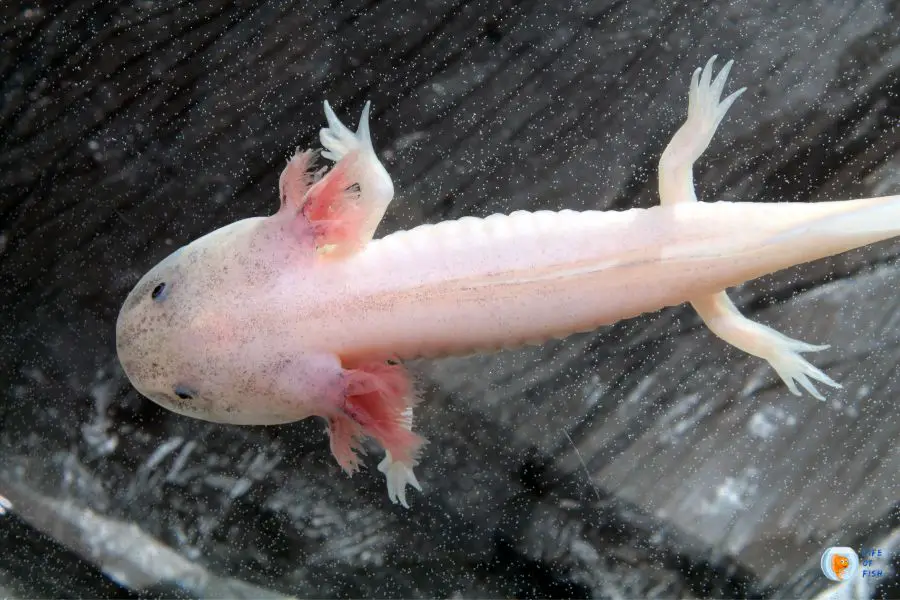
Tank setup
Setting up a tank for baby axolotls is not a big issue. They are not hard to handle species and you just need to care for a few things when you set up the tank. Baby Axolotls do not care much about plants, rocks, or other additions and you just need to keep a few decorations. IF your Baby Axolotl is shy, place a single piece of cover as its hiding spot. You can keep a cave or chunk of driftwood.
If you are keeping plants, it’s better to add floating plants as your clumsy Baby Axolotl can uproot the plants while it is hunting for food. You also can keep the plants in a pot to secure the roots. Keeping plants is a good move because these salamanders excrete considerable waste and plants can absorb ammonia, nitrite, and nitrate to some extent. This helps your aquarium filter to keep the water clean.Java grass, anubia barteri, and horword are excellent choices.
If you plan to house two Axolotls together, add more hiding spots to avoid conflicts.
Talking about the substrate, you can choose either an empty surface or a sand surface. It is easy to manage if you keep the surface empty. But if your Baby Axolotl can’t hold onto something on the surface, it might get depressing for them. Using fine sand is the most suitable and secure thing for the substrate. This is because the sand particles are microscopic and do not create any issues although your pet accidentally swallows sand particles. In addition, Baby Axolotls enjoy digging and playing with the sand. It helps them to improve their health and prevents them from becoming depressed.
Baby Axolotls are considered nocturnal species. Therefore use minimal lighting for their tank. They have poor vision but they are sensitive to bright light and using bright light in your aquarium is annoying them. Using LED light is the ideal option since you can adjust the intensity.
In the wild, Baby Axolotls live in dark muddy conditions and feel exposed if kept too well-lit. If your tank is located in a well-lit area, use black paper to cover the tank keeping one side for you to look at them. Keeping floating plants is another good way to dim the light. It also provides a beautiful lake environment which is a bit similar to the native environment of your baby axolotl.
Water quality condition
It is essential to provide suitable water conditions to improve the lifespan, health, and happiness of your baby axolotls. Usually, salamanders are somewhat hardy and long-lived. Therefore, it is not complicated to provide them with the right water parameters.
Lake Xochimilco mountain lake where the native place of Baby Axolotls is quite cool and you need to replicate the temperature of their native place to make them happy. The temperature of the water should be around 60-70°F (15-23°C). You can even put them in an environment that is a little warmer than the above temperature. Room temperature or a bit colder is ideal. However, make sure never to use an aquarium filter for the tank of Baby Axolotls.
They do not tolerate extremes in water hardness and pH. The pH range of 6.5-7.5 is ideal for them.
The Baby Axolotls are not too sensitive to high ammonia levels. But still, it is toxic, and better to keep the ammonia level at 0 ppm. The nitrite and chlorine concentration should be around 0 ppm. The water hardness and the Carbonated hardness should be 7-14 GH and 3-8 KH while the nitrate level should be 0-10 ppm.
These Salamanders are very messy creatures. They excrete a high amount of waste. Therefore, make sure to install a good water filter. If you keep them in a 10-gallon tank you should do partial water removals frequently. To avoid frequent water removals use a tank of 20 gallons to accommodate a single Baby Axolotl.
Special tips
If your Axolotl is still small don’t put sand as a substrate. This is because they accidentally swallow them and it can make your pet sick. Therefore, wait until the axolotl becomes about 5 inches or bigger to put sand as a substrate. Until then you can keep the bare tank without any substrate.
They have very soft skin. Therefore, make sure there are no sharp decorations. Even a small wound can make them sick. Since they have external gills, they absorb the medications you put in rapidly, which can harm their body. If you need to move them, use a soft aquarium net and move them quickly to another container. Make sure, their gills are not entangled in the net.
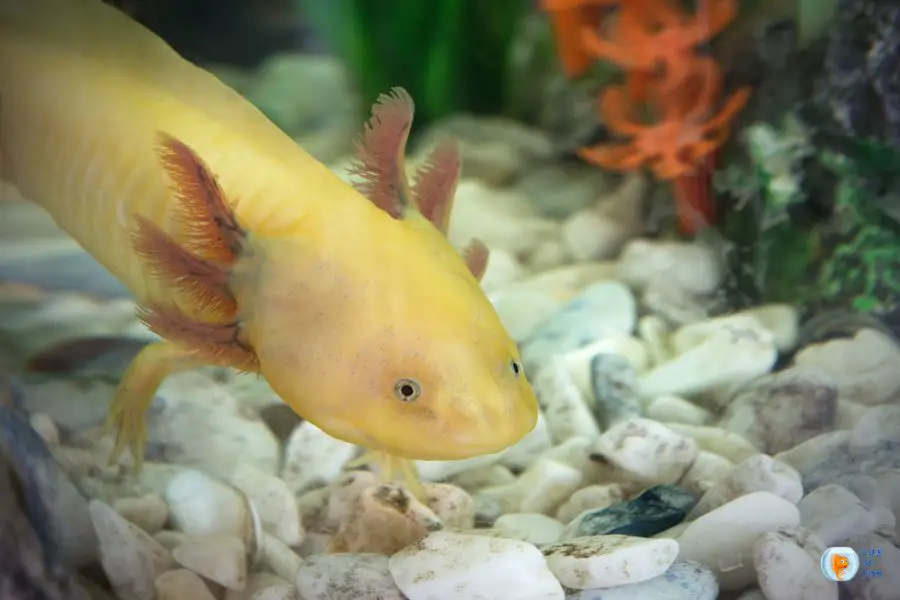
Baby Axolotl breeding
Identify female Axolotls
Male and female axolotls are a bit similar. The main distinguishable factor is their size. The male axolotls are larger in size and have longer tails. In addition, they have an enlarged cloacal area; also male axolotl has a visible lump there which is absent in females. In contrast, females have wider, fuller bodies to store eggs and they look plumper from above.
How to breed
Mating axolotls is a somewhat difficult and challenging thing if you have never done it before. The main concern is their very aggressive behavior towards the same species. First, you will need a spacious breeding tank. Get at least 40 gallons of the tank to accommodate fully grown male and female axolotl if you intend to keep them always living together. Otherwise, 20 gallons tank is enough. After the mating, you should separate them if you keep them in a 20-gallon tank.
Select the male and the female axolotl to pair. You can identify the male by the visible lump on his cloaca. In the wild, they mate throughout the late cold season and early summer season. It is better if you can replicate the late cold season by increasing the temperature by a few degrees. It stimulates their mating process.
Keep the water temperature within 70 degrees Fahrenheit (21 degrees Celsius). The male and female would engage in a ritualized mating process, once prepared to reproduce. While the male axolotl pushes the female in one direction, it will insert a spermatophore. The spermatophore is a capsule of testicles and the procedure is referred to as indirect implantation. The fertilization does not take much time and occurs quickly. The females often lay their eggs 12-72 hours after implantation.
You can see a mass of slime-covered eggs if the mating is over. Though female axolotls have the potential to produce up to 1500 eggs, you should separate the adults and the eggs after you see the mass of eggs in the breeding tank. Baby axolotls are famous for eating their own eggs, therefore, you must keep an eye on them during their mating season.
Some breeders separate and transfer the eggs into different tubes while keeping adult axolotls in their original aquariums. Not like many fish eggs they are a little bit tough and you can move them easily to another container. You can gently slice the exterior sticky coating of eggs to release the eggs. The eggs are surrounded by multiple layers of mucus. Therefore, you need to worry about cracking the eggs while moving. If your axolotl lays the eggs on the plant, it is easier to extract the eggs. You just need to remove the plants from the tank and grab the eggs.
According to the experts, eggs will hatch more quickly in higher temperatures. You can increase the temperature of the hatching container preferably within 70 degrees Fahrenheit (21 degrees Celsius). Eggs develop within 15 to 21 days, depending on the water temperature. Therefore, try to keep the water temperature at the optimal point.
The newborn axolotls look like tadpoles. Axolotls will not take food immediately after hatching. First, they will absorb their egg yolks. They will be ready to take on live foods after about 48-72 hours. They should be fed with brine shrimp until they become to a considerable length.
You can keep the newborn axolotls in the same tank for a little while, but make arrangements to move them quickly and put them in separate living quarters in order to avoid unnecessary fights.
How many babies do Axolotl have?
You can have hundreds of hatchlings per breeding.
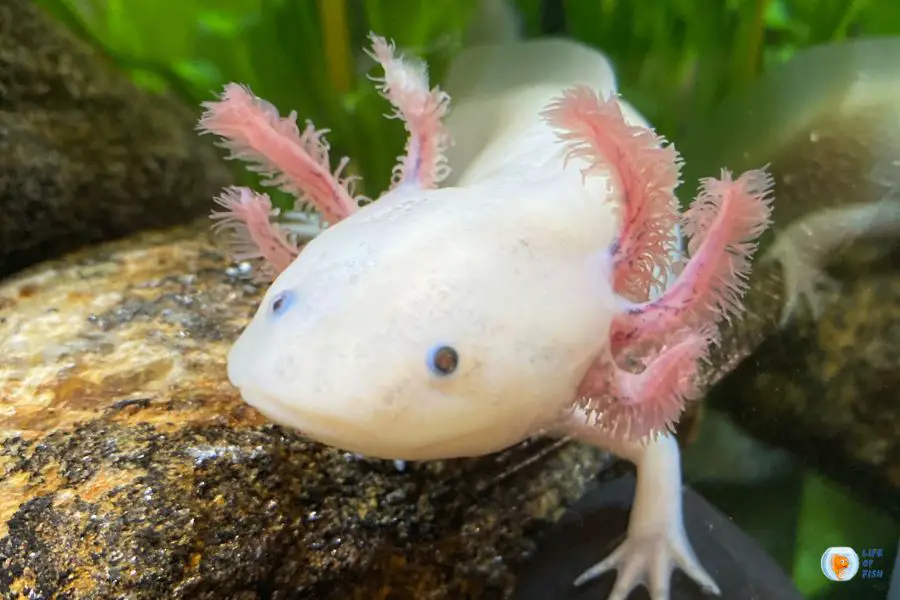
Baby Axolotl tank mates?
As described earlier, Baby axolotls are extremely aggressive and carnivorous species. They like to be alone alone. Keeping fish with the axolotls will end up with losing your fish if the fish is smaller than the axolotl. Even if you keep a large fish with your baby axolotl, it may snap at its fins. On the other hand, if you keep an aggressive fish, it may pick at its feathery external gills or its skin. Their skin is very sensitive and small wounds can make an infection. It is commonly considered that skin infections in amphibians are very hard to treat and often it will end up in the death of the animal.
It is also not a good idea to keep them with other types of tank mates like snails or shrimp as they will be a meal to baby axolotl soon.
Experts not recommended keeping two axolotls in one tank even unless you are trying to breed them. If you are keeping two of them make sure to provide them with at least 40 gallons of the tank. Further, provide them with a sufficient meal to release their stress.
Take every attempt not to cause any kind of injury to your baby axolotl. Since they are breathing through their skin they tend to absorb medications in huge doses. Therefore, it is hard to treat them if they get any infections.
What to feed Baby Axolotl
Baby axolotls are carnivores and they will eat almost anything that fits in their mouth. They prefer protein-rich live foods but accept frozen foods too. In the wild, they prey on bloodworms, bugs, tiny fish, and other animals.
You can provide a diversity of living and dead foodstuffs. Some of the possible foods are angleworms, Bloodworms, Brine shrimp, Frozen fish pellets, Skudge Worms, Standard fish food, and Small pieces of beef. They don’t require any vitamin or mineral supplements.
Although some aquarists claim that axolotls don’t accept pellet food, they can be trained to accept commercially processed foods. Especially, if your Baby axolotl accepts non-moving prey, frozen food is a good alternative. Use feeding tongs to feed them.
If you wish to provide them with live foods, make sure the live food you choose is from a source that is free of parasites. Experts suggest not using wild-caught live foods because of the parasite issue. The parasites might be passed onto axolotl if you feed them foods with parasites.
If you wish to feed them with dead foods then you may need to entice them. Baby axolotls are very sensitive to motion. Therefore, you need to shake the water with the use of your fingers or a pair of feeding tongs. Although, Baby Axolotls have an excellent sense of smell as well sometimes they won’t recognize dead food.
The metabolism of Baby Axolotls is so slow. Therefore, they need a small portion of food and also a baby axolotl just needs to eat two or three times per week. But you should feed the axolotls at their larval or young age daily two times. Full-grown adult axolotls eat even less often. Hence, you can feed them once a week for a substantial amount. The serving quantity should be around four tiny bugs per axolotl. It is said that a mature axolotl could survive for 14 days without any food.
Make sure, you don’t overfeed them. After feeding, remove any uneaten foods remaining in the tank to avoid water fouling. Especially, dead food or commercial foods cause ammonia levels to rise.
Recently asked questions
What Do You Need to Take Care of an Axolotl?
Caring for a pet Axolotl is somewhat complex for a beginner. You need to have a good understanding of their behavior and preferences. Also, it requires a great deal of maintenance. If you need more than one axolotl you need to have separate tanks for it. Baby Axolotls should not be handled. Therefore, you need a soft aquarium net to catch them.
Since they are creating a high amount of waste, you will need a heavy-duty water filter. Apart from those special needs, you need to keep the water parameters at their optimal.
Where Do Axolotls Originate From?
Baby Axolotls are exclusively found in the Xochimilco lake complex close to Mexico City. It comprises Lake Xochimilco and a series of man-made canals and waterways which crisscross throughout the Mexican capital and axolotls are confined to that particular area only. They are a popular Mexican delicacy and overfishing contributes to their appearance on the critically endangered species list.
There is a fascinating story behind their name which goes back thousands of years to the Aztec civilization in Mexico. There is a myth that the axolotls are the god of death named Xolotle who was said to have turned into an axolotl to escape being killed.
Read Next : Zebra Loach Care, Breeding, Feeding And Tank Mates
